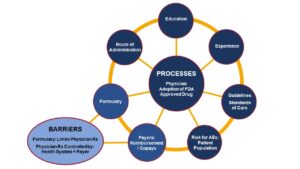Overview
Through real-world evidence (RWE), prescriptions reveal the process and delivery of healthcare. A prescription for a diagnostic test or medication reflects medical practice patterns, healthcare systems, and payer reimbursement for services. Much like “what gets measured, gets managed”, what gets prescribed and accepted by payers determines the healthcare services administered. Unfulfilled prescriptions are the difference between healthcare that is prescribed and delivered.
Reflecting barriers to care, unfulfilled prescriptions impact outcomes and reflect gaps in the healthcare system. These gaps in the healthcare system contribute to the social determinants of health (SDH). According to the Office of Disease Prevention and Health Promotion, there are 5 domains related to SDH that impact health, well-being and quality of life:
- Economic Stability
- Education Access and Quality
- Healthcare Access and Quality
- Neighborhood and Built Environment
- Social and Community Context
Prescriptions are an important indicator of SDH; written by providers and filled through two distinct processes:
- RWE reveals patterns of medical-decision-making, guidelines based standards of care, and physician knowledge and experience about a drug and/or disease. Patient-related factors, such as comorbidities and route of administration, individualize medical decision-making.
- Outside the physician’s control, healthcare system and payer constraints place limits on prescriptions. SDH have been recognized as significant factors regarding access to medical advances and specialty care centers.
Prescriptions: Processes and Potential Barriers After FDA Approval

Clinical Insights – SDH
In the last 10 years, the annual frequency of the term SDH in journal articles has increased seven-fold. The use of diagnosis codes to report factors influencing health status and contact with health services (Z-codes) has also increased, identifying social needs and the data quest toward better outcomes. Medicaid waivers have allowed health sector programs to include social support, such as transportation.
Comparing Medicaid and marketplace coverage for low-income adults, prescription fills were significantly greater among those with subsidized private insurance, even though total and out-of-pocket costs were higher.
- Emergency room visits, ranging from critical to non-emergent causes, were significantly fewer among patients with subsidized private insurance.
- Five of twelve quality measures favored private insurance, including mammograms, influenza vaccine, and hemoglobin A1c
- While only one quality measure (b-blocker use for coronary artery disease) favored Medicaid, no differences were found in the remaining six quality measures.
Outcomes for Patients with Cancer
With a wide range of health outcomes, there may be positive and negative SDH. For patients with cancer, delays in diagnosis and treatment are common, negative SDH. Time-to-treatment initiation (TTI) significantly impacts overall survival (OS). The importance of TTI was confirmed in an evaluation of over 2.2 million patients with non-metastatic breast, prostate, non-small cell lung cancer (NSCLC), or colon cancer who were diagnosed from 2004 to 2015, with data analysis conducted in 2020 to allow for a minimum 5-year follow-up period.
The most pronounced impact on OS was found among patients with stage III colon cancer and stage I NSCLC, with lesser impacts observed for patients with prostate and stage I breast cancers. As cancer-related mortality for breast cancer is highly stage-dependent, the impact of TTI is evident among patients with progression of disease and stage during treatment delays.
Access to medical advances and specialty treatment is associated with improved outcomes, including OS. Patients with lower income and negative SDH generally had inferior access to medical advances in these treatment centers. With improved therapeutic results and lower complication rates, treatment in specialty centers provides clinically-meaningful outcomes.
STATinMED RWD Insights
When a drug is used in a broader patient population with more comorbid conditions, differences exist between outcomes observed in clinical trials and RWE analysis. Outcomes are also impacted by SDH due to disparities in insurance coverage and access to specialty care. Like comorbidities, SDH provide an important understanding of the patient population and range of outcomes.
Our nationally comprehensive all-payer medical and pharmacy claims data encompasses >300 million patient lives. STATinMED RWD Insights includes many factors related to the SDH within analyzed demographics. Especially for newly FDA-approved drugs, we can monitor outcomes from:
- Specialty practices participating in clinical trials and have experience with the drug are generally among the first to prescribe newly-approved medical advances.
- Practices include academic comprehensive cancer programs and integrated network cancer programs with coordinated practice locations and healthcare professionals that treat >500 cancer cases per year
Considerations & Recommendations
Through analysis of comorbidities, demographic factors, health insurance providers and healthcare setting, STATinMED RWD Insights reveals more details about SDH, care, coverage and medical advances that will help patients and providers.

Sources
Allen H, Gordon SH, Lee D, et al. Comparison of utilization, costs, and quality of Medicaid vs subsidized private health insurance for low-income adults. JAMA Network Open. 2021;4(1):e2032669.
Butler SM. What is the outlook for addressing social determinants of health? JAMA Health Forum. 2021;2(9):e213639
Carey RM, Fathy R, Shah RR, et al. Association of type of treatment facility with overall survival after a diagnosis of head and neck cancer. JAMA Network Open. 2020;3(1):e1919697.
Cone EB, Marchese M, Paciotti M, et al. Assessment of time-to-treatment initiation and survival in a cohort of patients with common cancers. JAMA Network Open. 2020;3(12):e2030072.
US Department of Health and Human Services Office of Disease Prevention and Health Promotion. Social Determinants of Health. https://health.gov/healthypeople/objectives-and-data/social-determinants-health. Accessed 11/2/21.
US Department of Health and Human Services. Using Z Codes: The Social Determinants of Health (SDOH) Data Journey to Better Outcomes. https://www.cms.gov/files/document/zcodes-infographic.pdf. Accessed 11/2/21.
US Department of Health and Human Services. Centers for Medicare & Medicaid Services. https://www.cms.gov/medicare/icd-10/2021-icd-10-cm. Accessed Nov 2, 2021.
As real-world evidence authorities, STATinMED discovers data, develops insights and delivers optimal solutions to help life science companies realize maximum value.
We understand real-world evidence and solve problems with confidence. Contact the STATinMED Strategic Advisory Services Team to learn more!




